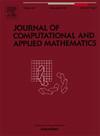半线性椭圆系统多解的谱Levenberg-Marquardt-Deflation方法
IF 2.6
2区 数学
Q1 MATHEMATICS, APPLIED
Journal of Computational and Applied Mathematics
Pub Date : 2025-08-09
DOI:10.1016/j.cam.2025.116998
引用次数: 0
摘要
许多实际问题产生非线性微分方程,这些方程可能表现出与应用相关的多个非平凡解。有效地计算这些解决方案对于深刻理解这些问题和增强各种应用程序至关重要。因此,发展一种能够有效地找到多个解的数值方法是必要的。此外,提供有效的迭代过程对于迅速获得多个解决方案是至关重要的。本文提出了一种识别半线性椭圆系统多解的新算法,首次将信任域Levenberg-Marquardt方法与通货紧缩技术相结合来计算多解。基于几个数值实验,我们的算法证明了高效识别多个解的有效性,即使这些方程中出现的非线性项只涉及一阶导数。此外,我们验证了算法的效率,并揭示了现有文献中以前未发现的解决方案本文章由计算机程序翻译,如有差异,请以英文原文为准。
A spectral Levenberg–Marquardt-Deflation method for multiple solutions of semilinear elliptic systems
Numerous practical problems give rise to nonlinear differential equations that may exhibit multiple nontrivial solutions relevant to applications. Efficiently computing these solutions is crucial for a profound understanding of these problems and enhancing various applications. Therefore, the development of a numerical method capable of finding multiple solutions efficiently is imperative. Additionally, the provision of an efficient iteration process is vital for promptly obtaining multiple solutions. In the current paper, we introduce a novel algorithm for identifying multiple solutions of semilinear elliptic systems, where the trust region Levenberg–Marquardt method, combined with the deflation technique, is designed to compute multiple solutions for the first time. Based on several numerical experiments, our algorithm demonstrates efficacy in efficiently identifying multiple solutions, even when the nonlinear term appearing in these equations involves solely the first derivative. Moreover, we validate the efficiency of our algorithm and unveil previously undiscovered solutions in the existing literature
求助全文
通过发布文献求助,成功后即可免费获取论文全文。
去求助
来源期刊
CiteScore
5.40
自引率
4.20%
发文量
437
审稿时长
3.0 months
期刊介绍:
The Journal of Computational and Applied Mathematics publishes original papers of high scientific value in all areas of computational and applied mathematics. The main interest of the Journal is in papers that describe and analyze new computational techniques for solving scientific or engineering problems. Also the improved analysis, including the effectiveness and applicability, of existing methods and algorithms is of importance. The computational efficiency (e.g. the convergence, stability, accuracy, ...) should be proved and illustrated by nontrivial numerical examples. Papers describing only variants of existing methods, without adding significant new computational properties are not of interest.
The audience consists of: applied mathematicians, numerical analysts, computational scientists and engineers.

 求助内容:
求助内容: 应助结果提醒方式:
应助结果提醒方式:


